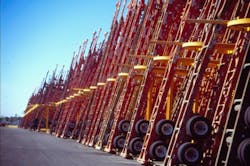Intermodal motor carriers are calling on steamship lines to change their business practices that often require truckers to only use certain chassis.
“Our ultimate goal is to have the ocean liners stop forcing motor carriers to use designated chassis providers when we are paying the bill and are responsible for that unit,” said Randy Guillot, president of Triple G Express Inc. in Jefferson, LA. “When we are responsible for the expense and running that unit, we want to be able to sure we can procure it in our fashion.”
Guillot is second vice chairman of American Trucking Associations (ATA) and immediate past chairman of the Intermodal Motor Carriers Conference. He spoke with Fleet Owner during the 2017 ATA Management Conference & Exhibition.
While in certain areas there are shared-use pools, Guillot called the chassis problem a “coast-to-coast issue” at U.S. seaports and many intermodal freight rail facilities.
“We feel this system is not right for the American people and the trucking industry,” Guillot said.
He expressed confidence there was growing support for changes, and that motor carriers “need to make sure it happens.”
Guillot explained that a Triple G trucker at a port could be forced into using a 20-year-old chassis that “may not be maintained to our standards.”
Nearby could be an unused new piece of equipment with additional safety technologies, but that driver is not banned from using it by the ocean liner. Additionally, there are cases where truckers are prevented from using other chassis, even when there is a delay caused by shippers running out of equipment.
“Motor carriers should have the ability to procure a safe piece of equipment at whatever cost level if that is what we choose,” Guillot stressed. “We don’t have that privilege in many cases.”
He said the U.S. supply chain would benefit from transitioning to the model more common in the rest of the world –giving motor carriers more choice when it comes to the chassis they want to use.
Guillot used the recent hurricanes as additional examples how this issue can impact overall safety.
He noted the flooding in Houston from Harvey cut into “the overall capacity of chassis in that city,” and that proper maintenance practices call for chassis in affected areas to be taken apart for inspection.
However, the truckers forced to use this equipment do not have guarantees the equipment is being maintained as well their tractors.
About the Author
Neil Abt
Neil Abt is a former FleetOwner editor who wrote for the publication from 2017 to 2020. He was editorial director from 2018 to 2020.

